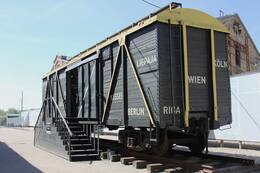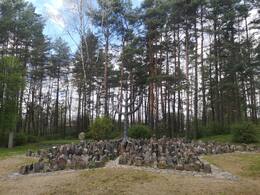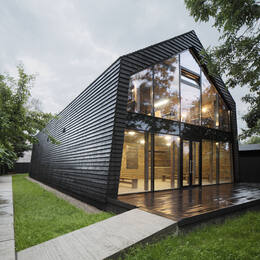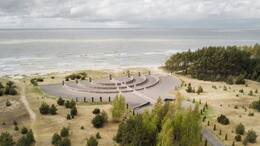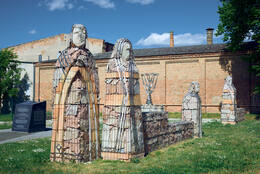Rygos getas ir Holokaustas
Sąmoningai buvo pasirinkti trijų skirtingų žmonių memuarų fragmentai, leidžiantys atidžiau pažvelgti į Holokausto nusikaltimą iš skirtingų perspektyvų.
Vokietijos armijos generolas majoras Walteris Brunsas stebėjo Rumbulos operaciją: „Duobės buvo 24 m ilgio ir apie 3 m pločio, jose reikėjo atsigulti kaip sardinėms skardinėje, galva per vidurį. Viršuje buvo šeši žmonės su kulkosvaidžiais, kurie tada šaudė į galvą. Kai atvykau, duobė jau buvo pilna, gyvieji turėjo gulėti ant viršaus, o tada buvo sušaudyti; taupant vietą, jie turėjo gulėti tankiomis eilėmis. [...] Priėję arčiau, jie pamatė, kas vyksta priešais juos. [...] Jie turėjo atiduoti savo papuošalus ir lagaminus. Geri daiktai sudėjo į lagaminus, o likusieji – į vieną didelę krūvą, šiek tiek toliau, jie turėjo nusirengti, o 500 m iki miško turėjo visiškai nusirengti, jiems buvo leista likti tik su marškiniais arba apatiniais. Jie visi buvo moterys ir maži vaikai, maždaug 2 metų amžiaus.“
ŽANIS LIPKE, žydų gelbėtojas: „Buvau nedidelėje žmonių grupelėje, apimtoje siaubo, stovėjusioje už geto tvoros ir stebėjusioje, kas vyksta už spygliuotos vielos. Kilo tikras chaosas: žmonės bejėgiškai bėgo iš vienos vietos į kitą, rėkė, verkė. Vieni tempė ryšulius ir lagaminus, kiti nešė vaikus ant rankų arba stūmė juos vežimėliuose. Girti policininkai tyliai šaukė ant žmonių, tempė juos iš butų ir negailestingai mušė. Kai kurie policininkai, tuščiai žiūrėdami, šaudė atsitiktinai – tiesiai į minią. [...] Vokiečių kareiviai ir Latvijos policininkai mušė ir šaudė į tuos, kurie atsiliko nuo kolonos. Nužudytų žmonių kūnai buvo palikti gatvėje, kuria žmonės buvo varomi šaudyti. Didelio namo kieme mačiau daug moterų ir kūdikių kūnų. Namas stovėjo Lačplēšos gatvėje, šalia spygliuotos vielos tvoros, kuri buvo pastatyta aplink „getą“.
BAILA HAMBURGA, Rygos geto kalinė, Rumbulos kampanijos išgyvenusioji: „Žmonės lėtai judėjo į priekį, policija šaukė „greičiau, greičiau“, bet niekas nepadėjo. Mes tapome abejingi, gyvenimo valia išblėso. Ėjome Maskavas gatve, žmonės stovėjo prie langų ir žiūrėjo į mus. Kai kurie šluostėsi akis, bet mačiau ir tokių, kurie juokėsi. Vienas net parodė kumštį. Pasiekėme gumos fabriką „Kvadrāts“, esantį miesto pasienyje, ir ėjome toliau, kol išgirdome daug šūvių. Dabar vaikai garsiai verkė. Policija jau buvo girta ir tik ragino „greičiau, greičiau“.
Generolas majoras Walteris Brunsas (1891–1957) buvo vokiečių armijos inžinerijos pulkininkas, dislokuotas netoli Rygos 1941 m. pabaigoje ir matęs masines žudynes Rumbule. Jis buvo sugautas 1945 m. balandžio 8 d. ir laikomas kaliniu britų internuotojoje stovykloje, skirtoje vokiečių karininkams. Šiuose sulaikymo centruose buvo įrengti klausymosi įrenginiai, todėl kalinių pokalbiai buvo įrašinėjami ir įrašinėjami. Viename tokiame pokalbyje tarp Brunso ir kitų karininkų jis kalbėjo apie įvykius Rumbule, pateikdamas įrodymų apie Holokaustą Rygoje. 1948 m. Brunsas davė parodymus kaip liudininkas Vermachto vyriausiosios vadovybės teisme. Tais pačiais metais jis buvo paleistas iš kalėjimo.
Žanis Lipke (1900–1987) buvo Rygos uosto dokininkas. Naciams okupavus Rygą, jis norėjo padėti žydų bendruomenei. Tam jis įsidarbino Liuftvafės sandėliuose netoli Centrinio turgaus, esančio netoli Rygos geto. Jam teko vesti žydus į sandėlius ir iš jų. Lipke pasinaudojo šia proga, kad paslėptų kai kuriuos žydus, jog jiems nereikėtų grįžti į getą, o galėtų nuvykti į Lipkės namus, kur jis jau buvo jiems paruošęs bunkerį. Vėliau Žanis Lipke su pažįstamais Rygoje ir Duobelėje rado kitų vietų slėpti žydus. Iš viso Žanis Lipke ir jo padėjėjai išgelbėjo daugiau nei 50 žmonių.
Beila Hamburga buvo Rygos geto kalinė, išgyvenusi Rumbulos operaciją. Ji mirė Štuthofo koncentracijos stovykloje.
Prisiminimai skelbiami Latvijos okupacijos muziejaus svetainėje. Prieiga per internetą: http://okupacijasmuzejs.lv/rumbula/
Susijusi laiko juosta
Susijusios temos
Susijusios vietos
Rygos getas ir Latvijos Holokausto muziejus
Rygos geto ir Latvijos Holokausto muziejus yra įsikūręs Rygoje, netoli Rygos centrinio turgaus ir Rygos centrinės stoties. Muziejus buvo atidarytas 2010 m. toje vietoje, kur anksčiau buvo miesto sandėliai. Jis įsikūręs istorinėje miesto dalyje, šalia buvusio žydų geto sienos. Geto teritorija yra unikali, nes architektūros požiūriu ji nepasikeitė nuo Antrojo pasaulinio karo. Tai memorialas, skirtas žydų tautos tragedijai. Vokietijos politika žydų gyventojų atžvilgiu Latvijoje iki 1939 m. pabaigos buvo tokia, kad Vokietijos diplomatai ir politikai bandė daryti spaudimą Latvijos vyriausybei, kad ši imtųsi veiksmų prieš žydus, apribodama jų laisvę. Po Baltijos vokiečių emigracijos 1939 m. Vokietijos ambasada nebeturėjo tokios geros prieigos prie informacijos apie gyventojų nuotaikas ir įvykius Latvijoje kaip anksčiau. Kai Raudonoji armija okupavo Latviją, ji manipuliavo visuomene, kad gautų žydų gyventojų paramą naujajai okupacinei valdžiai. Tačiau po to, kai režimas pradėjo represijas prieš visą visuomenę, parama sparčiai sumažėjo. Dėl viso to tarp žmonių susiformavo gilus susiskaldymas. Vėliau kitas režimas – Vokietija – bandė tuo pasinaudoti. Jie tikėjosi, kad vietos gyventojai persekios ir puls žydus, tačiau taip neatsitiko. Taigi, Vokietija pakoregavo savo požiūrį ir parengė naują planą – iš pradžių įkurti žydų getą, o vėliau sunaikinti jo gyventojus.
Žydų memorialas Rumbule
Įsikūręs Rumbuloje, netoli Maskavas gatvės.
Rumbula yra viena didžiausių masinio žydų naikinimo vietų Europoje. Per dvi akcijas – 1941 m. lapkričio 30 d. ir gruodžio 8 d., kurios buvo įvykdytos remiantis nacių vadovybės sprendimu visiškai sunaikinti Rygos gete kalintus žydus, Rumbulos miške buvo sušaudyta daugiau nei 25 000 žmonių, įskaitant apie 1000 iš Vokietijos deportuotų žydų. 1944 m. Rumbuloje taip pat buvo nužudyti keli šimtai žydų vyrų iš Kaiservaldo koncentracijos stovyklos.
Pirmieji bandymai įamžinti Rumbuloje nužudytų žydų atminimą datuojami septintojo dešimtmečio pabaiga. Nepaisant sovietų valdžios apribojimų, pavienių žydų iniciatyva 1963 m. prie vienos iš Rumbulos pušų buvo pritvirtinta medinė atminimo lenta su užrašu jidiš kalba, o prie Rumbulos geležinkelio (netoli Rygos–Maskvos linijos) buvo įrengtas didelis menininko Josifo Kuzkovskio plakatas „Žydas“. Plakate buvo pavaizduotas vyras, tarsi kylantis iš kapo sugniaužtu kumščiu, simbolizuojantis protestą prieš tai, kas buvo padaryta. Ir atminimo lenta, ir plakatas buvo pašalinti 1964 m., tačiau žydams pavyko gauti leidimą įrengti Rumbuloje atminimo akmenį su užrašu „Fašizmo aukoms“ ne tik latvių ir rusų kalbomis, bet ir jidiš kalba.
2002 m. lapkričio 29 d. Rumbuloje atidarytas architekto Sergejaus Rižo suprojektuotas memorialinis ansamblis. Jo statybą finansiškai parėmė Latvijos, Izraelio, JAV ir Vokietijos institucijos bei privatūs asmenys.
Pakelėje, prie kelio, vedančio į memorialą, pastatyta metalinė konstrukcija kaip ženklas, simbolizuojantis nacizmo pajėgas. Netoliese yra akmuo su paaiškinimu, kad šiuo keliu buvo mirtinai suvaryti tūkstančiai žydų. Prie įėjimo į memorialą kelios akmeninės lentelės su užrašais latvių, anglų, vokiečių ir hebrajų kalbomis supažindina su Rumbulos tragedijos įvykiais ir memorialo įkūrimo istorija. Centrinėje memorialo dalyje, virš aikštės, kuri yra Dovydo žvaigždės formos, kyla septynšakė žvakidė – menora, aplink kurią sudėti akmenys su Rumbulos nužudytų žydų vardais. Atskiruose akmenyse iškalti buvusio Rygos geto gatvių pavadinimai, kuriais išgrįsta aikštė. Memorialo teritorijoje yra keletas masinių kapaviečių, kurių vietos pažymėtos stačiakampiais betoniniais bordiūrais.
Žanio Lipkės memorialas
Žanio Lipkės memorialas yra Kipsaloje, Rygoje. Žanio Lipkės muziejus yra bene vienas labiausiai paslėptų muziejų Rygoje. Nesuprantama memorialo vieta nėra atsitiktinumas ir turi simbolinę reikšmę. Jis įrengtas buvusios požeminės slėptuvės, kuri buvo sukurta žmonėms gelbėti Antrojo pasaulinio karo vokiečių okupacijos metu, vietoje. Čia Žanis Lipke ir jo šeima išgelbėjo 55 žydus. Šiandien memorialas pastatytas šalia Žanio Lipkės šeimos namo. Memorialas „Juodasis tvartas“ yra simbolinis pastatas, kuriame buvo teikiama ir priimama prieglauda. Pastato dizainas buvo paimtas iš istorinių Kipsalos žvejų ir jūreivių degutu dengtų trobelių. Šios trobelės buvo pastatytos naudojant baržų medžiagas, todėl jos turėjo labai savitą spalvą ir deguto kvapą. Tačiau unikali ne tik šios istorinės vietos istorija. Taip pat pastebimas ir tai, kaip muziejus perteikia savo žinią. Bendras dizainas panašus į Biblijoje aprašytą Nojaus arką, be to, jis primena į krantą ištrauktą ir apvirtusią valtį – valtį, kuri atliko savo užduotį. Šio memorialo koncepcija kyla iš šios vietos ir istorijos istorinio tikslumo bei su ja susijusių liudijimų. Tai istorija apie laisvės troškimą, neįtikėtiną pabėgimą ir pasitikėjimą. Pakeliui į muziejų taip pat galėsite pamatyti istorinius Pardaugavos pastatus.
Liepojos Holokausto aukų memorialas
Didžiausias Holokausto aukų memorialas Latvijoje yra Liepojoje, Šķēdės kopose. Memorialas skirtas daugiau nei 3000 Liepojos žydų, nužudytų Antrojo pasaulinio karo metu, atminimui. Jis yra Izraelio nacionalinio simbolio – septynšakės žvakidės, vadinamos menora, – formos. Memorialo kontūrai, aiškiai matomi iš paukščio skrydžio, sudaryti iš skaldytų riedulių ir granito luitų. Menoros „šviesos“ – tai granito stulpai su Jeremijo raudų eilučių užrašais hebrajų, anglų, latvių ir rusų kalbomis.
Atminimo memorialas „Sinagogos sodas“ (Sinagogas dārzs)
Memorialas yra miesto centre, netoli Bauskės savivaldybės Turizmo informacijos centro ir Rotušės aikštės.
Jis sukurtas Bauskės žydų palikuonių Izraelyje, JAV ir Didžiojoje Britanijoje iniciatyva ir aukomis, taip pat Bauskės savivaldybės tarybos ir Latvijos žydų bendruomenių bei bendrijų paramos dėka.
Memorialą suprojektavo skulptorius Girtis Burvis. Jis yra buvusios Bauskės Didžiosios sinagogos dydžio, o akmens statulos simbolizuoja žydus, išeinančius iš sinagogos po pamaldų. Memorialo centre stovi simbolinė bima – paaukštinta platforma arba stalas, naudojamas sinagogoje per žydų religines apeigas. Ant jos parašyta: „Pagarba Bauskės žydams, kurie čia gyveno šimtmečius ir kūrė šį miestą, o 1941 m. buvo nužudyti nacių ir jų vietinių parankinių. Pagerbiant žydų tautos atminimą – Bauskės žydų palikuonys ir Bauskės gyventojai.“
1935 m. Bauskėje gyveno beveik 800 žydų. 1941 m. liepą, prasidėjus nacių okupacijai, daug žydų buvo suimti ir išvežti, o apie 700 žydų sušaudyti. Bauskės Didžioji sinagoga buvo sugriauta per Antrąjį pasaulinį karą.





